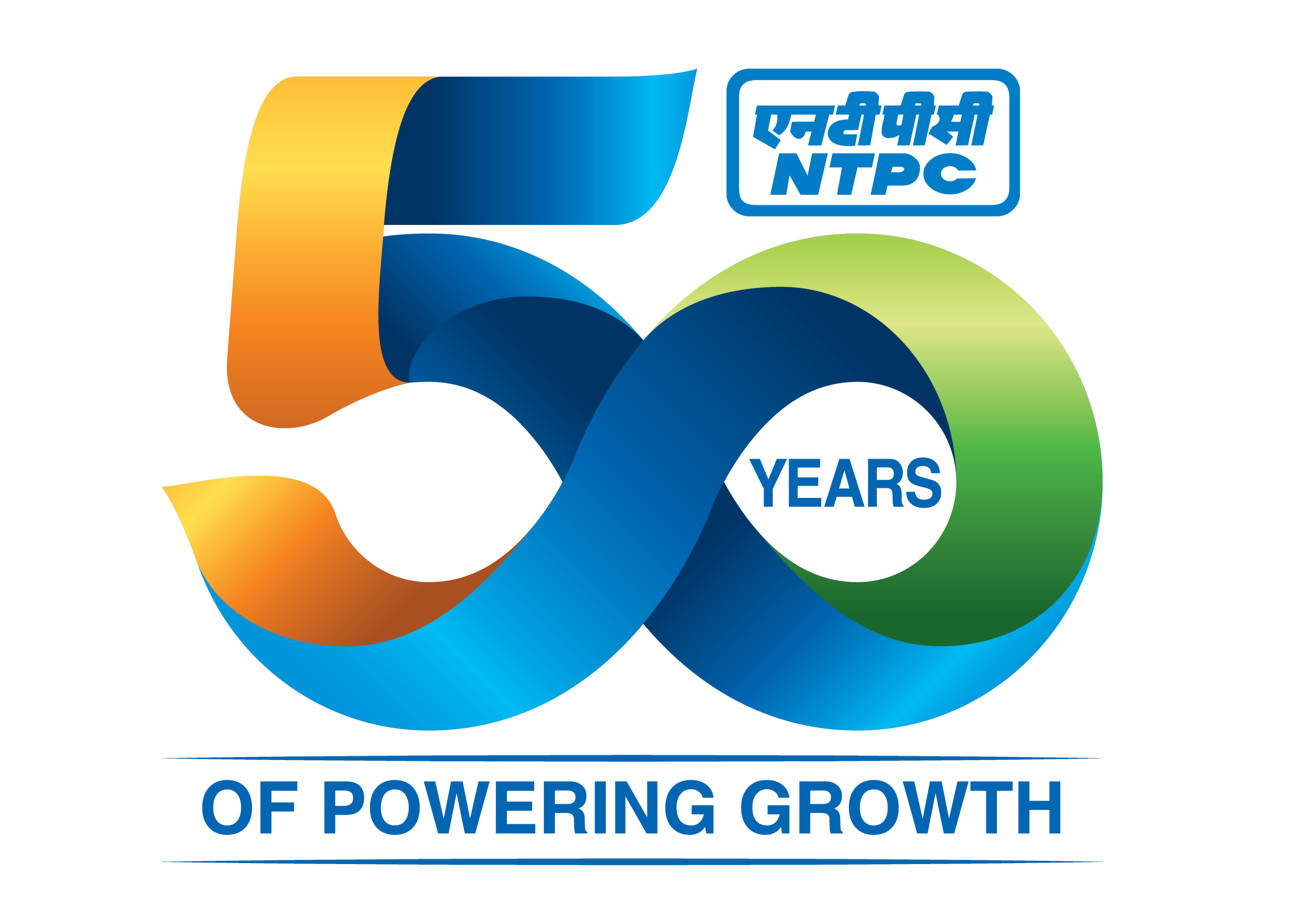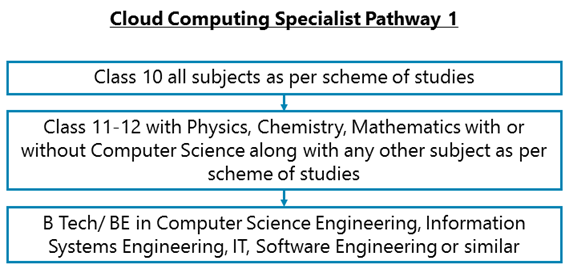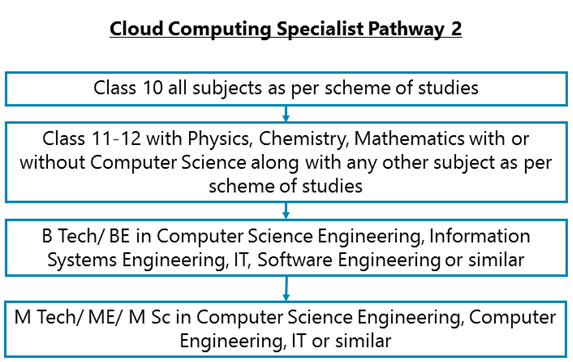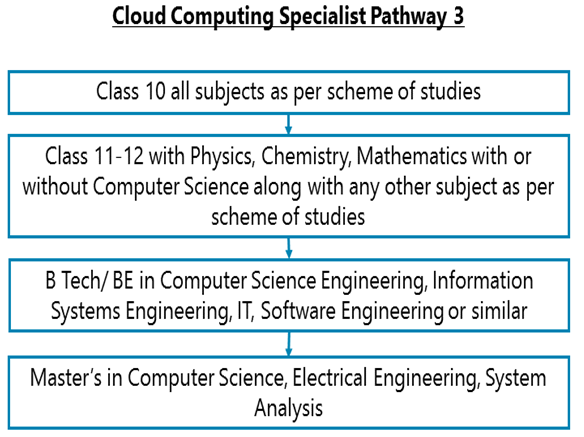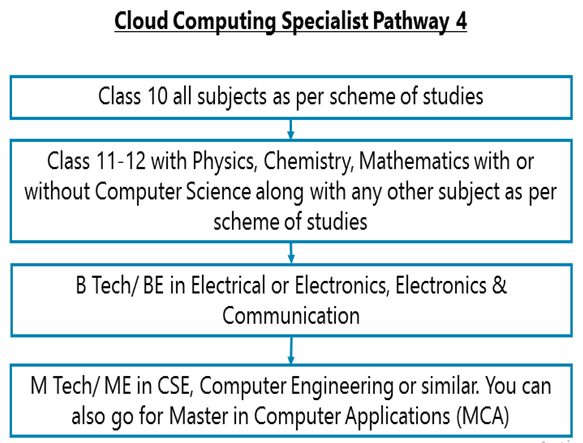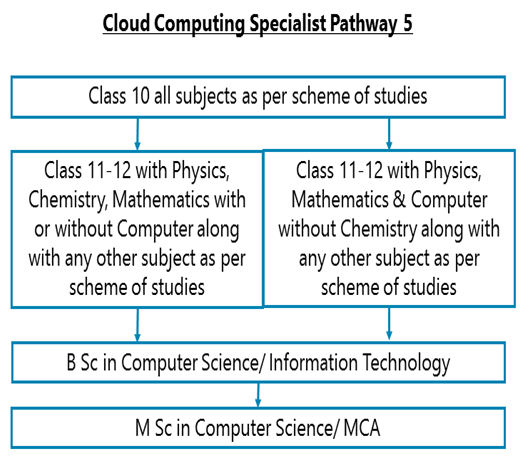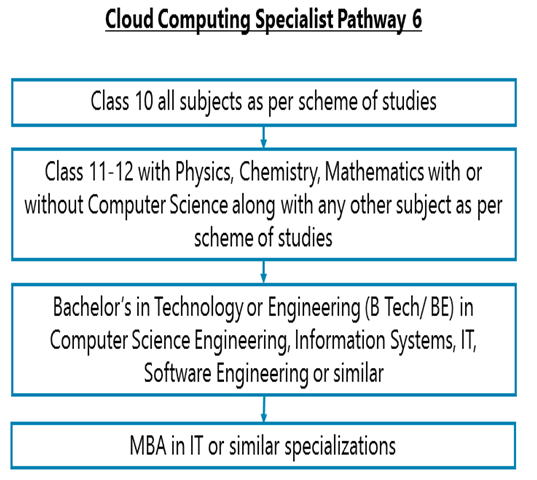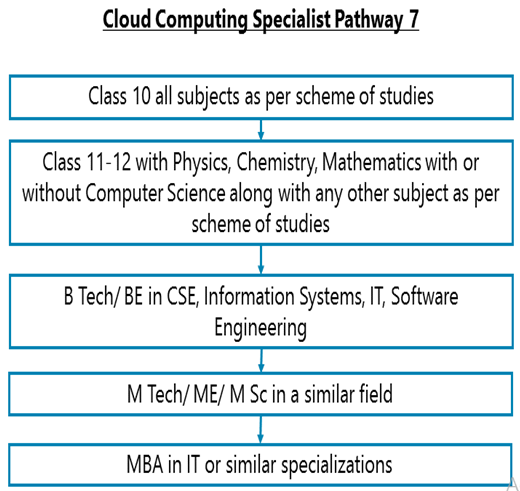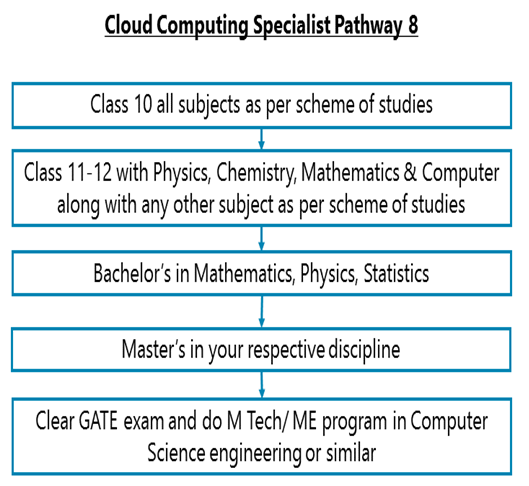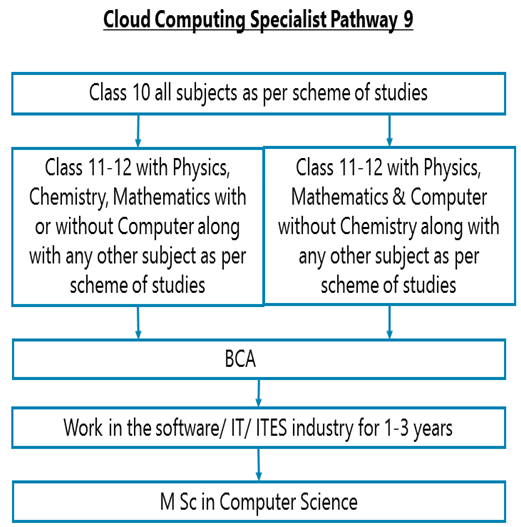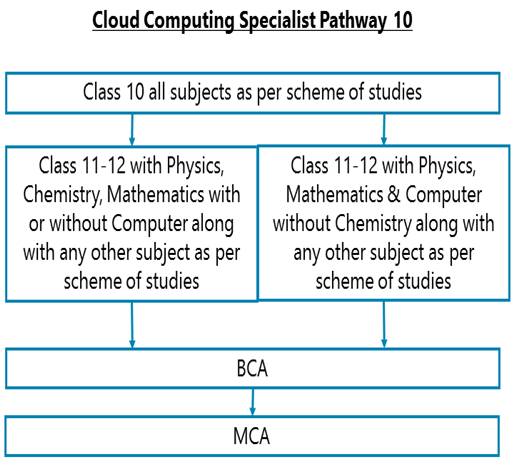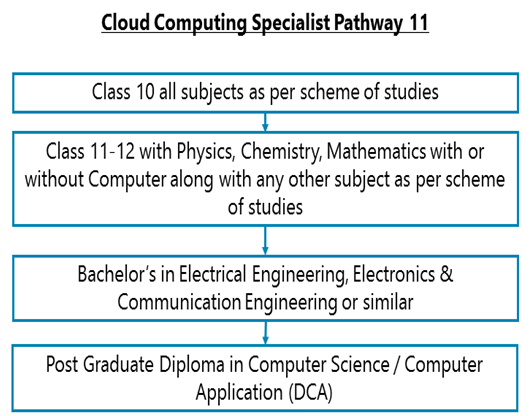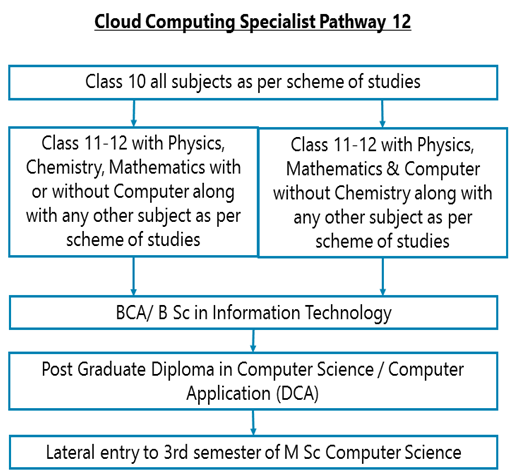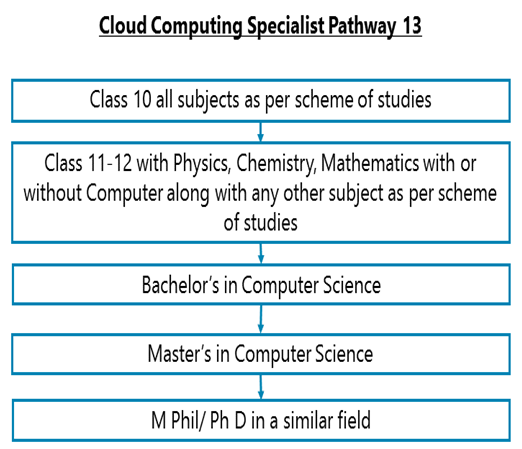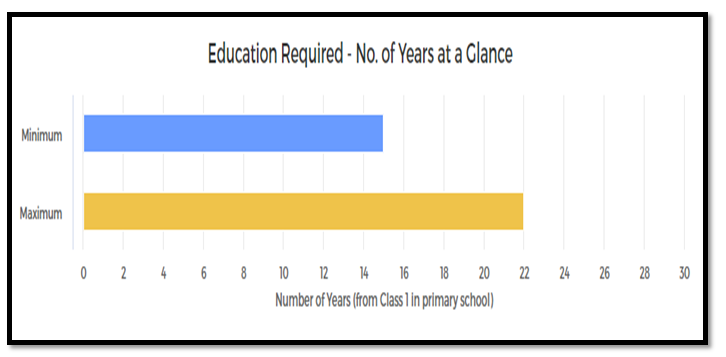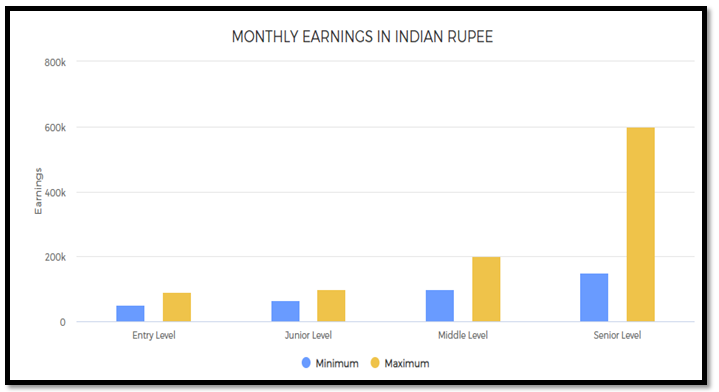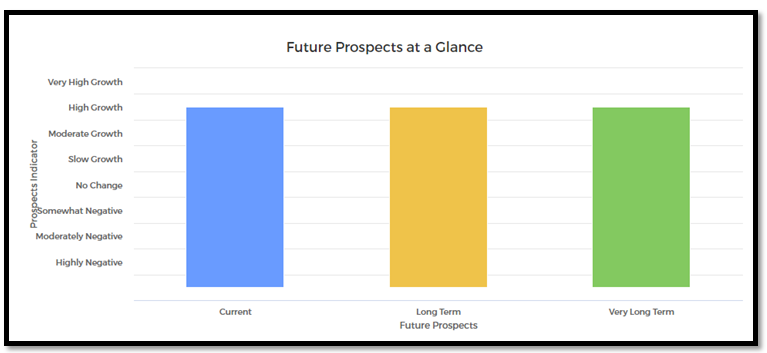Cloud Computing Specialist
Entry Level Qualification
12
Career Fields
Information Technology & Computer Science
For Specially Abled







 ,
,
Career Entrance Exam
About Career
PARTICULARS | DESCRIPTION |
Name | Cloud Computing Specialist |
Purpose | Manage Cloud-Based Systems And Services |
Career Field | Information Technology & Computer Science |
Required Entrance Exam | JEE MAIN BE/BTECH, JEE ADVANCED, GATE |
Average Salary | 600000 - 1100000 Rs. Per Year |
Companies For You | Amazon Web Services (AWS), Microsoft Azure, IBM Cloud & Many More |
Who is Eligible | Class 12th Pass |
As a Cloud Computing Specialist, you will actively participate in the development of cloud-based information technology infrastructures. ‘Cloud’ basically refers to the information technology services rendered over a communication and data transmission network, use of which could be limited to a single organization, available to many organizations, available to people at a specific geographical area, or to the public at large all over the world.
What are the basic uses of a cloud?
Cloud-based infrastructures are available-on-demand computer system resources especially used for data storage or executing small, medium to high scale applications ranging from composing & sending an email to running a program for making meteorological predictions or studying 6 billion molecules of the human genome! Simplistically, this means virtual data centers and applications which are simultaneously available to many users over the Internet handling different types of tasks.
New Age Demands
The new “on-demand” lifestyle of the current generation of us necessitates information to be available anytime, anywhere and on any device. Mobility has become the new normal and cloud computing is the engine to deliver all of this.
Cloud computing continues to roll ahead as more and more organizations adopt this technology, but seriously, what we're really watching is an increase in how organizations are utilizing the Internet. There are more computing resources out there, better underlying alternative systems support and a greater need to distribute data.
Ease of Access – A Cloud That We Can Finally Reach
Multiple people across geographically dispersed locations can access, store, manage, use information stored in these virtual data centers or use software programs loaded on the servers of these virtual data centers to run some functions on physical computers located anywhere in the world whenever required. These software programs ‘respond to call requests’ made by multiple people simultaneously from different parts of the world.
Why Use Cloud?
What cloud does is helping companies and individuals from investing in IT hardware and software for all the applications they need on their computers, mobile phones, and other such devices. Meaning that companies and individuals no longer have to invest in expensive hardware and software to do all the things that they want done. They can simply use applications on cloud – processed and run on remote servers but available on local computers through the internet.
The second context is – distributed or shared computing – so that if you need a very large volume of data processing or storing or to run a complex application (which requires a high level of processing power including processor speeds and RAM), you will not have to install it on your local computer. You can run the application, process the data, store the data remotely on one or more remote servers using cloud tech.
Take an example
‘Sound cloud’ (a website & mobile app) uses cloud computing. Musicians (called creators) register themselves and upload their music on the app. There is only 1 copy ever of every music file that's uploaded. Listeners (called “followers") listen to the real-time streaming for free. The best part: personal collections of tracks can be made and accessed from any device, anytime, anywhere. The music copies always stay up in the nebulous ‘cloud’. No one but Soundcloud needs to know & care about that place where all the music is stored.
There are chiefly 4 separate types of clouds:
Public cloud
Public cloud is a network shared by different organizations to render services that may or may not be free of charge but is open for public use. These services are made available by a service provider for a public audience.
A particular ‘public cloud service provider’ (only a few in the market today - Amazon Web Services, Google, Microsoft, Alibaba, IBM, and Oracle) own & operate their individual cloud infrastructure entirely at their data centers and access is generally allowed to users via the Internet. Anyone can create a free Amazon Web Services (AWS) account and start practicing with the console.
All companies globally that require specific cloud computing skills or services are typically already committed to a specific cloud provider, any of these. So, before starting out to scout for jobs you will have to master any or more than one of these provider’s platforms such as the AWS console. You will also need to possess pretty good programming skills in one or the other modern scripting languages in order to find your way through these platforms.
Private cloud
A private cloud infrastructure is operated solely for a single organization, internally or by a third party. However, implementation of such an infrastructure is controlled completely by the enterprise. They are hence also referred to as internal clouds.
Private clouds are implemented in the company’s data center. It maintains all corporate data resources under the legal umbrella of the organization. Self-run data centers are generally capital intensive, result in several additional expenses, raise various security concerns and also have to be refreshed periodically.
Community cloud
A community cloud infrastructure can be established where many organizations have similar types of requirements and seek to share the infrastructure so as to collaboratively realize some of the benefits of cloud computing. This is controlled and used by a group of organizations that have shared interests.
They are spread over fewer users than a public cloud but much more than a private cloud. As for an example think of some functions across government/ federal departments which can be carried out by establishing a common networking scenario through a community cloud, access to which is shared only between those departments.
Hybrid cloud
Hybrid cloud is a composition of a public and a private cloud. It is the more popular option among enterprises. But the challenge is connecting a public and private instance together to form a robust and secure cloud environment. It allows us to extend either the capacity or the capability of a cloud service, by integration, aggregation, or customization with another cloud service.
Take for an example, an organization may store sensitive client data internally on a private cloud, but interconnect some features of it partially to another business intelligence public cloud application shared to all its clients as a ready to use software over the Internet. Such a hybrid cloud extends the capabilities of the enterprise to deliver a specific business service to its clients.
Cloud Computing principally includes 4 service models:
Software as a Service (SaaS)
This service model allows a consumer to access any application stored in the cloud. This involves the cloud provider installing & maintaining software in the cloud and users running that software on their local computer or mobile phone or similar devices from the cloud over the Internet.
The applications are easily accessible through various client devices — for example, Zoho Books which is a cloud-based accounting solution suitable for small organizations. Organizations can also connect bank & credit card accounts to match with transactions.
Another common example would be Google Appstore on Android phones with all the applications, games, etc. provided as SaaS.
Platform as a Service (PaaS)
This service model enables users to develop, run, & manage applications without the complexity of building & maintaining the entire infrastructure traditionally in a non-cloud-based system, the steps which are typically associated while developing and before launching an app.
The cloud provider offers the networks, servers, storage, operating system (OS), middleware, database and other services to a user/ developer.
The original intent of PaaS is to simplify the code-writing process for developers, with the infrastructure & operations handled by the PaaS provider.
Originally, all PaaSes were in the public cloud. However, private & hybrid PaaS options were created later as most companies did not want to have everything in the public cloud. These are managed by internal IT departments.
If you have some application which you have written in some language, and you want to deploy (test, run or make downloadable) it over the public/ private/ hybrid cloud, you would choose something like Heroku or AWS Elastic Beanstalk. There are several others.
Infrastructure as a Service (IaaS)
Infrastructure as a service is taking physical hardware and going completely virtual. This service model allows users to access the storage, networks, and any required computing resources to help them deploy and run any software.
In other words, businesses pay a monthly or annual fee to run virtual servers, networks, storage from the cloud. This mitigates their need for a data center, heating, cooling, & maintaining all hardware at the local level. Amazon Web Services (AWS) is an example of an IaaS service provider.
Robotics as a Service (RaaS)/ Cloud Robotics
Cloud robotics attempts to invoke cloud technologies centered on shared services for robotics. This service model facilitates the seamless integration of robots& embedded devices into the Web and a cloud computing environment.
When connected to the cloud, robots can benefit from the powerful computation, storage, & communication resources of modern data centers in the cloud shared between various robots or agents (other machines, smart objects, humans, etc.). This type is emerging to be a highly prospective and industrially relevant service model given the rise of Industry 4.0.
Key Roles and Responsibilities
As a Cloud Computing Solutions Architect, you will be engaged with one or more of the following roles & responsibilities as well as other associated duties:
1. You will assist in the architecture, design & support of advanced computational platforms and work on projects focusing on very large distributed data storage, computation infrastructure, architecture design, new innovative cloud-based applications/ services and improving existing cloud-based service offerings. This involves writing/ editing software programs/ code sets frequently in popular scripting languages.
2. You will design & extend cloud computing and big-data storage systems as well as improve automated cloud configuration, deployments, monitoring, management, and incident response.
3. You will configure, administer, operate & maintain components of cloud computing platforms such as IBM Bluemix, Microsoft Azure etc.
4.You will compose, develop & maintain scripts (codes or computer programs) to automate deployment (getting new software up and running properly in its environment, including installation, configuration, running, testing) and other tasks.
5. You will also be responsible for writing unit tests/ acceptance tests (software programs), and work closely with engineers to build internal tools to demonstrate performance & operational efficiency.
6. You will be determining & sharing best practices in cloud performance measurement, migration, and implementation based on leading industry trends.
7. You will have to work with other teams to resolve issues related to application configuration, deployment, or debugging as well as research technical alternatives and develop alternative strategies for faulty designs.
8. Your work has to be compliant with infrastructure, privacy, security, cloud hosting and other policies.
Career Entry Pathway
Class 10 all subjects as per scheme of studies – Class 11-12 Physics, Chemistry, Computer (optional)and Mathematics along with any other subject as per scheme of studies - B Tech/ BE in CSE, Information Systems Engineering, IT, Software Engineering or similar
After completing Class 11-12 Physics, Chemistry, Computer (optional)and Mathematics along with any other subject as per scheme of studies, you can go for B Tech/ BE in Computer Science Engineering, Information Systems Engineering, IT, Software Engineering or similar.
Class 10 all subjects as per scheme of studies – Class 11-12 Physics, Chemistry, Computer (optional)and Mathematics along with any other subject as per scheme of studies - B Tech/ BE in CSE, Information Systems Engineering, IT, Software Engineering or similar – M Tech/ ME/ M Sc in Computer Science Engineering, Computer Engineering, IT or similar
After completing Class 11-12 Physics, Chemistry, Computer (optional)and Mathematics along with any other subject as per scheme of studies, you can go for B Tech/ BE in Computer Science Engineering, Information Systems Engineering, IT, Software Engineering or similar. Then go for post-graduation: M Tech/ ME/ M Sc in Computer Science Engineering, Computer Engineering, IT or similar.
Class 10 all subjects as per scheme of studies – Class 11-12 Physics, Chemistry, Computer (optional)and Mathematics along with any other subject as per scheme of studies - B Tech/ BE in Electrical or Electronics, Electronics & Communication, CSE – Master’s in Computer Science, Electrical Engineering, System Analysis
After completing Class 11-12 Physics, Chemistry, Computer (optional)and Mathematics along with any other subject as per scheme of studies, you can go for B Tech/ BE in Computer Science Engineering, Information Systems Engineering, IT, Software Engineering or similar. Then go for a Master’s in Computer Science, Electrical Engineering, System Analysis.
Class 10 all subjects as per scheme of studies – Class 11-12 Physics, Chemistry, Computer (optional)and Mathematics along with any other subject as per scheme of studies - B Tech/ BE in Electrical or Electronics, Electronics & Communication – M Tech/ ME in CSE, Computer Engineering or similar/ MCA
After completing Class 11-12 Physics, Chemistry, Computer (optional)and Mathematics along with any other subject as per scheme of studies, you can go for B Tech/ BE in Electrical or Electronics, Electronics & Communication. Then go for M Tech/ ME in CSE, Computer Engineering or similar. You can also go for Master in Computer Applications (MCA).
Class 10 all subjects as per scheme of studies – Class 11-12 Physics, Chemistry, Computer (optional)and Mathematics along with any other subject as per scheme of studies - B Tech/ BE - M Tech/ ME /MCA
After completing Class 11-12 Physics, Chemistry, Computer (optional)and Mathematics along with any other subject as per scheme of studies, you can go for B Tech/ BE in Electrical or Electronics, Electronics & Communication. Then go for M Tech/ ME in CSE, Computer Engineering or similar. You can also go for Master in Computer Applications (MCA).
Class 10 all subjects as per scheme of studies – Class 11-12 Physics, Chemistry, Computer (optional)and Mathematics along with any other subject as per scheme of studies - B Tech/ BE in CSE, Information Systems, IT – MBA (IT)
After completing Class 11-12 Physics, Chemistry, Computer (optional)and Mathematics along with any other subject as per scheme of studies, you can go for Bachelor’s in Technology or Engineering (B Tech/ BE) in Computer Science Engineering, Information Systems, IT, Software Engineering or similar. Then you can pursue an MBA in IT or similar specializations.
Class 10 all subjects as per scheme of studies – Class 11-12 Physics, Chemistry, Computer (optional)and Mathematics along with any other subject as per scheme of studies - B Tech/ BE in CSE, Information Systems, IT – M Tech/ ME/ M Sc in Computer Science Engineering, Computer Engineering, IT or similar – MBA (IT)
After completing Class 11-12 Physics, Chemistry, Computer (optional)and Mathematics along with any other subject as per scheme of studies, go for B Tech/ BE in CSE, Information Systems, IT, Software Engineering then M Tech/ ME/ M Sc in a similar field. Thereafter pursue an MBA in IT or similar specializations.
Class 10 all subjects as per scheme of studies – Class 11-12 Physics, Chemistry, Computer and Mathematics along with any other subject as per scheme of studies - Bachelor’s in Mathematics, Physics, Statistics – M Sc – M Tech in CSE
After completing Class 11-12 Physics, Chemistry, Computer and Mathematics along with any other subject as per scheme of studies, you can go for Bachelor’s in Mathematics, Physics, Statistics and then go for a Master’s in your respective discipline. Thereafter clear GATE exam, to gain entry into an M Tech/ ME program in Computer Science engineering or similar.
Class 10 all subjects as per scheme of studies – Class 11-12 Physics, Chemistry (optional), Computer (optional)and Mathematics along with any other subject as per scheme of studies - BCA – work in Software / IT / ITES Industry - M Sc in Computer Science
After completing Class 11-12 Physics, Chemistry (optional), Computer (optional)and Mathematics along with any other subject as per scheme of studies, you can go for a Bachelor’s in Computer Applications. Then work in the software/ IT/ ITES industry for 1-3 years. Thereafter go for M Sc in Computer Science.
Class 10 all subjects as per scheme of studies – Class 11-12 Physics, Chemistry (optional), Computer (optional)and Mathematics along with any other subject as per scheme of studies - BCA – MCA
After completing Class 11-12 Physics, Chemistry (optional), Computer (optional)and Mathematics along with any other subject as per scheme of studies, you can go for a Bachelor’s in Computer Applications (BCA) and then pursue Master’s in Computer Applications (MCA).
Class 10 all subjects as per scheme of studies – Class 11-12 Physics, Chemistry, Computer (optional) and Mathematics along with any other subject as per scheme of studies –Bachelor’s in Electrical Engineering, Electronics & Communication Engineering or similar - Post Graduate Diploma in Computer Science / Computer Applications
After completing Class 11-12 Physics, Chemistry, Computer (optional) and Mathematics along with any other subject as per scheme of studies, go for a Bachelor’s in Electrical Engineering, Electronics & Communication Engineering or similar then Post Graduate Diploma in Computer Science / Computer Applications.
Class 10 all subjects as per scheme of studies – Class 11-12 Physics, Chemistry (optional), Computer (optional)and Mathematics along with any other subject as per scheme of studies - BCA/ B Sc in Information Technology – Post Graduate Diploma in Computer Science / Computer Application - Lateral entry to 3rd semester of M Sc Computer Science
After completing Class 11-12 Physics, Chemistry (optional), Computer (optional)and Mathematics along with any other subject as per scheme of studies, you can go for BCA (Bachelor of Computer Applications)/ B Sc in Information Technology. Thereafter go for a Post Graduate Diploma in Computer Science / Computer Application. Then you can take a direct lateral entry to 3rd semester of M Sc Computer Science. This is only offered by select reputed universities in India.
Class 10 all subjects as per scheme of studies – Class 11-12 Physics, Chemistry, Computer (optional) and Mathematics along with any other subject as per scheme of studies - B Sc Computer Science – M Sc Computer Science – M Phil/ Ph D in a similar field
After completing Class 11-12 Physics, Chemistry, Computer (optional) and Mathematics along with any other subject as per scheme of studies, go for Bachelor’s in Computer Science, then a Master’s in Computer Science, followed by an M Phil/ Ph D in a similar field.
Class 10 all subjects as per scheme of studies – Class 11-12 Physics, Chemistry, Computer (optional)and Mathematics along with any other subject as per scheme of studies - B Tech/ BE - M Tech/ ME/ M Sc - PhD
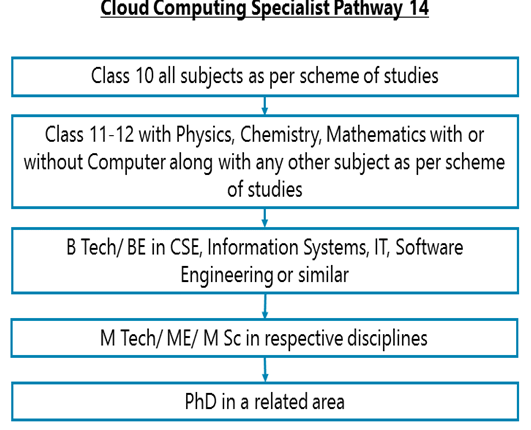
After completing Class 11-12 Physics, Chemistry, Computer (optional)and Mathematics along with any other subject as per scheme of studies, you can go for B Tech/ BE in CSE, Information Systems, IT, Software Engineering or similar, then M Tech/ ME/ M Sc in respective disciplines followed by a PhD in a related area.
Required Qualification & Competencies
After Class 11-12:
1. You can go for a Bachelor’s in Computer Science or any of the engineering fields especially Electrical/Electronics, Electronics & Communication. Information Systems Engineering or similar
2. Bachelor degree in Physics, Mathematics, Statistics
3. You can go for a Bachelor’s degree in Computer Applications or similar
Acquiring any among these professional certifications will prove to be beneficial in the long run:
1. WS Certified Solutions Architect
2. Certificate of Cloud Security Knowledge
3. Certified OpenStack Administrator (COA)
4. Cisco CCNA-Cloud
5. Cloud Credential Council
6. Cloud Institute Certifications
7. CompTIA Cloud Essentials
8. Exin Cloud Computing Foundation
9. Google Certified Professional Cloud Architect
10. IBM Certified Cloud Solution Architect v2
11. Microsoft Cloud Certifications
12. Red Hat Certified Architect: Cloud
You can study for a Bachelor’s / Master’s / Doctoral degree in any of the following fields (Note that all these fields may not offer you a degree at all three levels, that is in Bachelor’s, Master’s and Doctoral. Some fields may offer a degree only at the Master’s or at the Doctoral level):
1. Computer Science & Engineering
2. Cloud Computing (Computer Science)
3. Software Engineering
4. Cloud Computing
5. Artificial Intelligence & Machine Learning (Computer Science)
6. Cloud Computing & Information Security
7. Computer Networking (Computer Science)
8. Computer Science and Management
9. Information and Computer Engineering and Technologies
10. Computer Networks & Information Security
11. Programming and Software Engineering
12. Quantum Computing
13. Web Technology
MINIMUM EDUCATION REQUIRED | MAXIMUM EDUCATION REQUIRED |
Under Graduate Undergraduate Degree / Honours Diploma / Graduate Diploma (equivalent to a Degree) Programs for which the minimum eligibility is a pass in Higher Secondary / Class XII School Leaving examination. | Doctoral All Ph.D. or equivalent degree programs for which the minimum eligibility is a Postgraduate or a Pre-Doctoral degree. |
COMPETENCIES REQUIRED
Interests
1. You should have interests for Investigative Occupations. Investigative occupations involve working with ideas and quite a lot of thinking, often abstract or conceptual thinking. These involve learning about facts and figures; involve the use of data analysis, assessment of situations, decision making and problem-solving.
2. You should have interests for Enterprising Occupations. Enterprising occupations involve taking initiatives, initiating actions, and planning to achieve goals, often business goals. These involve gathering resources and leading people to get things done. These require decision making, risk-taking, and action orientation.
3. You should have interests for Realistic Occupations. Realistic occupations often involve physical activities for getting things done using various tools and equipment.
Knowledge
1. You should have knowledge of Computers– Knowledge of computer hardware and software, computer programming, computer networks, computer, and mobile applications.
2. You should have knowledge of scripting technologies including Bash, KSH, Perl, Python, VBScript, Windows Powershell, Ruby, Java, JavaScript, Chef, Puppet, etc.; Hadoop and Big Data concepts; network tools such as tables, Linux IPVS, HAProxy, etc.; system monitoring tools such as Nagios, Cacti, Meninx, Big; enterprise backup tools such as NetBackup, Legato, TSM.
3. You should have knowledge of virtualization technologies such as Bochs, Xen, VMWare; installing, configuring, & maintaining services such as Bind, Apache, MySQL, Nginx; messaging frameworks such as RabbitMQ, Kafka, Storm, Hadoop
4. You should build experience around cloud systems, supporting cloud architectures and cloud-based application implementation efforts, creating and maintaining operating system builds/images, automated deployment technologies, common Web/Application containers, AWS environment management, development tools, and development environments.
5. You should have a sound understanding of system environments such as Windows desktop and Mac OS; systems management tools experience for e.g. SCCM, BigFix, Nexthink, etc.
6. You should have experience in the broad application of 1 or more higher-level programming languages such as Python, Java/Scala, MATLAB, R or C/C++.
Skills
1. You should have Scientific Skills - in using various scientific rules and methods to get things done or solve problems.
2. You should have Technical Skills - using various technologies and technical methods to get things done or solve problems.
3. You should have Quality Control Analysis Skills - conducting tests and inspections of products, services, or processes to evaluate quality or performance.
4. You should have experience working independently under general direction within the scope of an assignment and use sound judgment in determining methods, techniques, and evaluation criteria.
5. You should have Systems Analysis Skills - determining how a system should work and how changes in conditions, operations, or the environment will affect outcomes.
6. You should have enough verbal and written communication skills necessary to effectively collaborate in a team environment and present technical ideas/results.
7. You should have Critical Thinking skills- Skills in the analysis of complex situations, using logic and reasoning to understand the situations and take appropriate actions or make interpretations and inferences.
8. You should have Judgment and Decision Making Skills - considering pros and cons of various decision alternatives; considering costs and benefits; taking appropriate and suitable decisions.
9. You should have Problem Solving Skills - Skills in analysis and understanding of problems, evaluating various options to solve the problems and using the best option to solve the problems.
10. You may need Programming Skills - writing computer programs for various applications, installation of computer programs and troubleshooting of problems in computer programs or software.
11. You should have Systems Evaluation Skills - identifying measures or indicators of system performance and the actions needed to improve or correct performance, relative to the goals of the system.
Ability
1. You should have Deductive Reasoning Ability - apply general rules and common logic to specific problems to produce answers that are logical and make sense. For example, understanding the reasons behind an event or a situation using general rules and common logic.
2. You should have Problem Sensitivity - The ability to tell when something is wrong or is likely to go wrong. It does not involve solving the problem, only recognizing there is a problem.
3. You should have Inductive Reasoning Ability - to combine pieces of information from various sources, concepts, and theories to form general rules or conclusions. For example, analyzing various events or situations to come out with a set of rules or conclusions.
4. You should have Information Ordering Ability - to arrange things or actions in a certain order or pattern according to a specific rule or set of rules (e.g., patterns of numbers, letters, words, pictures, mathematical operations).
5. You should have Oral Comprehension Ability - listen to and understand information and ideas presented through spoken words and sentences.
6. You should have Oral Expression Ability - communicate information and ideas in speaking so others will understand.
7. You should have Fluency of Ideas - The ability to come up with several ideas about a topic (the number of ideas is important, not their quality, correctness, or creativity).
Personality Traits
1. You are always or mostly careful about your actions and behavior.
2. You are always or mostly disciplined in your action and behavior.
3. You are always calm or generally remain calm in most situations.
4. You can always act independently or could do so in most situations.
5. You always prefer to experience new things and have new experiences, or you mostly do.
Career - Job Opportunities & Profiles
Work in this field of Cloud Computing is not very diverse. People work mainly in IT departments of enterprises operating in different industrial sectors including automotive, manufacturing, warehouse, logistics, agriculture, healthcare, retail, banking, entertainment, cleaning, personal care, and education for a wide range of pay.
Companies that require specific Cloud Computing skills or development skills are typically already committed to a specific cloud provider, such as Amazon Web Services (AWS), Microsoft Azure or Google Cloud Platform. All graduating Engineers/ Science graduates with some form of specialization in Cloud Computing can find excellent placements in research-oriented industries and top ranking global companies.
You may first join as a Trainee Engineer/ Research Intern/ Graduate Trainee/ Program Extern/ Client Services Intern/ Support Intern or directly in one of these positions depending on your educational qualifications:
1. Cloud Computing Architect
2. Cloud Intelligence Engineer
3. Cloud/Openstack Engineer
4. Cloud Computing Specialist
5. Cloud System Administrator
6. Migration & Modernization Specialists – Cloud Solutions
7. Cloud Computing Solutions Engineer
8. Cloud Project Management
9. Cloud Computing DevOps Engineer
10. Enterprise Architect - Cloud
11. Cloud Intelligence Networking Researcher
12. Cloud Subject Matter Architect
13. Cloud Systems Engineer
Various types of companies may recruit you:
1. Big Data, cloud computing leviathans (large groups of companies) which are dealing with cloud data integration and data integrity offering suites of applications for power analytics and business intelligence such as:
1. Talend, IBM, Dell Boomi, Hitachi Data Systems, Oracle, etc.
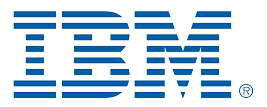
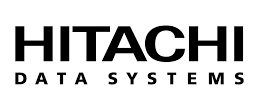

2. Internet & IT giants and cloud platform developers such as: Google, Microsoft, Facebook, Tencent, Twitter, Amazon Web Services, etc.

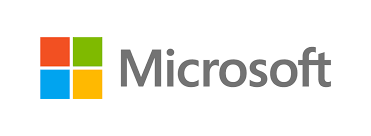


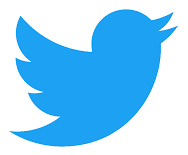
3. Online retailing companies such as: Flipkart, Alibaba, etc.


4. Gaming, media and entertainment industry with biggies such as Nvidia, Sony Interactive Entertainment PlayStation, Electronic Arts, Blizzard Entertainment, MGM, Twentieth Century Fox etc.
Health Tech –
Providers of medical image and information products and technologies for acquiring, processing, managing and storing diagnostic images and related data such as Fujifilm, etc.
Companies such as MetaMind involved in deep learning networks, image recognition, text analysis, machines/systems/devices to cater to the healthcare sector or
Healthcare analytics solutions & services companies such as Geneia LLC that focus on improving systems to support personalized, patient-centered care
Innovative software solutions companies that design products to protect patient safety, mitigate operational risks, and reduce cost and time of drug development such as Covance Inc. etc.
5. Consumer electronics & communications companies, TV businesses, mobile phone businesses such as TCL Corporation, Haier, Panasonic, Sharp, Sony, Samsung, LG Electronics, JVC, Toshiba, Fujitsu and Philips etc.
6. Other IT companies focused on software engineering in the field of AI such as IPSoft, OpenAI, AlphaSense, AIBrain, CloudMinds, Deepmind, H20, Iris AI, Active.ai, etc.
7. Space research and administration organizations such as NASA, ISRO, etc.
8. Fin-Tech - Companies that are into the BFSI industry such as insurers, consultancies, financial institutions, investment banking companies or others like Kasisto, Tesorio, Splunk, YotaScale Inc, Zestfinance, Scienaptic Systems, Underwrite.Ai, Kensho etc.
9. Networking & Technology/research divisions of Deloitte, Goldman-Sachs, JP Morgan Chase.
SPECIALISATION TRACKS IN THIS CAREER
Cloud Computing Solutions Architect (Hardware virtualization)
Virtual means remote access. Meaning, say, 100 persons can use the same hardware located anywhere in the world – in this case a ‘virtual’ desktop is created at any 1 out of these 100 persons’ local machines. A local machine then has a virtual version of the server hardware – which further means that the operating software and the application software all sit on the remote server while a local machine is a virtual version where the applications are merely run (Only the user interfaces are displayed on the local machines while applications are actually processed at the server hardware). Virtualization experts ensure that applications or business services do not directly depend on local hardware infrastructure. A virtual machine (VM) can be more easily controlled and inspected from a remote site than a physical machine. For example, a salesperson going to a customer with a laptopcan run a required software from a virtual machine located somewhere remotely. This means that if the required software is located at a virtual location, s/he can simply use it through a remote server without having to install it on the laptop. Like in most IT companies today, individuals are given a local machine with stripped down hardware and software load. This is then connected to the remote server through internet and the moment it is connected the local machine becomes a virtual main machine with some restrictions and can run any application located in the remote server through the internet/ intranet.
Cloud Computing Engineer (Security & Identity Management)
Clouds must make use of a security infrastructure to enable fast and safe transfer of information. Here, security concerns fall into 2 broad categories: security issues faced by cloud providers (such as Amazon, Google, Microsoft) and security issues faced by their customers. An organization (customer of Amazon/ Google/ Microsoft or another provider) may decide to store data or host applications on a public/ hybrid cloud. As a result, potentially sensitive data is at risk of data loss, getting malware, ransom attack, DDoS attacks, etc. as several organizations are simultaneously using the public cloud. Larger the organization, larger is the risk. The job of security engineers of that organizationis to protect the data centre servers or the main servers at the organization. So, they will deploy encryption protocols, firewalls, anti-virus software, and so on. They will run system hack to find loopholes and ensure that the loopholes are plugged. They will continuously monitor cyberattacks and defend against the attacks. So, these engineers are cybersecurity expert except that they work to protect the cloud infrastructure. All cloud service providers store thousands of customers’ data on the same server viz. many such organizations together, in order to conserve resources, cut costs, and maintain efficiency. So, servers of providers will require a much higher level of security firewalls & security software. The job of security engineers working with provider companies likes Amazon etc. is the same but in more robust ways.
Cloud Application Developer (Application Tools)
Development tools are for further enhancing & facilitating cloud’s distributed computing capabilities. Cloud Application Development Architects are trained software developers dedicated to writing software codes, either to perform a fresh task or collection of tasks, to build a gameor perform faster through individual add-ons or building the next generation of firewalls. For example, think Google Docs, PubG or anyof the Google applications from the AppStore that you can think of (whichever, whatever) are written by these developers and deployed through the public cloud. Even small enhancements, that are made every time there is a version upgrade, are done by these developers. You need not work with Google, you may have your own development company and spread your applications on the public cloud through Google AppStore.
MBaaS Specialist (Mobile "backend" as a service-MBaaS)
MBaaS Specialists deal with this service model to provide a way to link the products of application developers (third party developed applications) to cloud storage & cloud computing services with application programming interfaces (APIs). An application program interface (API) is a set of routines, protocols, and tools for building software applications. For example, recently a company has developed a way of using Bluetooth instead of GPS to identify a user’s proximity to a certain object which is definitely better in case of indoor settings. Bluetooth will use lower energy for communication. Now, without MBaaS, to build the above system an architect will be required to fire up an AWS Elastic Compute Cloud (EC2) for instance, run a Node.js server, set up & configure the database, set up the service, manage users, secure data, set up push notifications and integrate with other platforms (for e.g. iOS, Android etc.)if required.
All of this is taken care of by anMBaaS provider.
Migration & Modernization Specialists (Function as a service-FaaS, Serverless Computing)
FaaS and serverless computing are categories of cloud computing services which execute applications (sets of software codes) but do not usually ‘store’ data. One can run code sets on it without having to manage servers. It may be used to respond to web requests or even to compose & send emails. So, experts building serverless computing/ FaaS architectures allow customers (developers) to develop, run, & manage software programs (codes) without the complexity of building & maintaining the infrastructure while developing and launching an application/ applet (small portions of applications). You may come across the term ‘microservices’ used often today as most software codes for applications are broken down into smaller modules to make them lightweight. These micro-applications are run mostly on FaaS platforms.
Cloud Intelligence Networking Researcher (Distributed cloud)
Distributed cloud researchers assemble a cloud computing platform from a distributed set of machines at different locations (multiple geographic locations), all connected to a single network. Distributed cloud makes communications for global services or communications within a specific region much faster. These computers located at geographically dispersed locations collaborate on computer-intensive and/or compute-intensive tasks. Compute-intensive tasks are those which require a great deal of computation such as meteorological applications or software that feed on genetic code etc. Computer-intensive tasks are those which require the resources of a lot of computers like in case of ‘grid computing’ to achieve a specific task such as cryptocurrency mining.
Cloud Subject Matter Architect (Big Data cloud)
Initially the cloud system was not adopted for dealing with Big Data such as for business analytics, logistics or satellite data sourcing etc. because of the tall task of transferring huge amounts of data to the cloud and also keeping it safely there. But now, however, most companies dealing with Big Data finds cloud operations as most suitable as the speed of the internet is exceptionally improving. Subject Matter Architects building cloud platforms for storing and handling Big Data are the most desired across industry verticals today as volumes of data are being generated by the minuteand cloud becomes the preferred means of storage as well as execute application logic.
High-Performance Computing (HPC) Architect – Cloud Solutions
Cloud Computing Specialists dealing with HPC applications, which are compute-intensive tasks, build cloud-based architectures that can handle these tasks requiring a great deal of computation such as meteorological applications or software that feed on spatial disposition (geometric coordinates) of atoms in a super-large molecule etc. or other scientific number-crunching mechanisms. These consume considerable amount of computing power & memory and were otherwise traditionally executed on clusters of computers.
CAREER GROWTH
If you join as a Trainee Engineer/ Research Intern/ Graduate Intern/ Program Intern/ Client Services Intern/ Support Intern, then after completion of your training, you will be positioned as Cloud Computing Architect/ Cloud Intelligence Engineer/ Openstack Engineer/ Cloud Computing Specialist/ Cloud Computing Solutions Engineer or in similar positions. However, if you join after your post-graduation or higher advanced qualifications in a relevant discipline, you can surpass traineeship/ internship to directly get a job as anyone of these positions.
After 5-7+ years of experience, you can expect to become a Cloud Intelligence Senior Engineer, Senior Platform Engineer, Tech Lead, Principal DevOps/Cloud Architect, Principal Storage Engineer, Senior Tech Lead, Product Manager, Deputy/ Assistant Manager, etc.
After 8-12+ years in this field, you can grow into roles like that of a Senior Principal Cloud Computing Engineer, Manager-Infrastructure Support Services; Cloud Solutions Manager; Delivery Manager; Senior Manager Enterprise Infrastructure or similar roles.
Then after 15+ years of experience, you may grow as a Member of Technical Staff, Cloud Backup; Head of Engineering, AI & Machine Learning; Vice President, Enterprise Cloud & DevOps Practice; Area Vice President; Vice President, Cloud Operations; Senior Vice President, Technology Risk; Corporate Vice President, Strategy & Internal Consulting; Director of Infrastructure and Operations; Director Enterprise Architecture Strategy; Managing Director, Endpoint Engineering; Senior Director, Infrastructure Engineering; Chief Information Technology Officer (CITO), CEO or similar roles.
Salary Offered
1. In India, the salary of an entry-level cloud professional varies between Rs 5 lakh to Rs 7 lakh per annum which is greater than that of a traditional IT engineer who earns about Rs. 3 lakh to 5 lakh per annum.
2. At the entry-level jobs with private companies, after your post-graduation, you may expect to get about Rs. 50,000 – 90,000 or even more a month. In junior level jobs (after 5+ years of post-graduation), you can make about Rs. 65,000 – 1,00,000 or more per month.
3. In mid-level jobs with private companies in India, you can expect to earn about Rs. 1,00,000 – 2,00,000 or even more a month.
4. The salary for an associate working in the cloud with less than 5 years of experience can range from Rs 12 to 19 lakh per annum, while a mid-level manager can easily command upwards of Rs. 20 lakh per annum.
5. In senior-level jobs with private companies in India, you can expect to earn about Rs. 1,50,000 – 6,00,000 or even more a month.
6. After a Master’s degree, a stipend in India while doing a Ph.D. is about Rs. 35,000-38,000 a month in a university or research center or as a Research Associate with a salary of about Rs. 15,000-20,000 a month.
7. After a Ph.D., stipend for Post-Doctoral Fellows is Rs. 40,000-45,000 a month or as a Research Scientist/ Scientist E or similar positions in a research institution or university research center you will be remunerated according to the following.
8. In other organizations/companies mostly after a Ph.D. as a Scientist or after a Post-Doctoral Fellowship as a Scientist, salaries in India may vary between Rs. 50,000-1,20,000 a month or even more. Some opportunities do exist as an RA after Master’s. Salary would be about Rs. 25,000-35,000 a month.
9. The monthly salaries of faculty approved by the Ministry of HRD (Department of Higher Education), Govt. of India are:
Assistant Professor Grade-II: Rs 57700 to Rs 117200
Assistant Professor Grade I: Rs 101500 to Rs 204700
Associate Professor: Rs 139600 to Rs 211300
Professor: Rs 144200 to Rs 224100
10. Major opportunities today are concentrated at these locations Hyderabad, Bangalore, Mumbai, Pune, Vizag, Chennai, and Delhi in declining order of abundance.
Global (US)
1. At the entry-level jobs, after your Master's degree depending upon the institution where you are graduating from, you may expect to get about, USD 2500 – 6200or, even more, a month. Work opportunities are rare for graduates from India who have completed their post-graduation in the US. Most recruiters operating in this field will require you to be a green card holder, national citizen or a permanent resident in the country.
2. However, if you can obtain an advanced degree (in healthcare, management, IT, robotics, AI, ML, etc.) after your post-graduation in a relevant discipline there, you may start with temporary or assistive roles like that of a Graduate/ Doctoral/ Higher Level/ Part-time Teaching Assistant or Graduate Program Assistant or Summer Intensive Instructor or at similar positions and then gradually work your way up the ladder.
3. For larger MNCs (think Microsoft, Google, etc.) with operational units in India, you may be placed on a temporary/ contractual basis for project-based work at international locations while you are permanently posted in India. Some do get permanently transferred to such locations too however that is few and far between.
4. With junior level jobs, you may expect to earn around USD 4000-8500a month or more depending on your job location and roles.
5. In mid-level jobs, you can expect to earn about USD 5000 – 10200or, even more, a month.
6. In senior-level jobs, you can expect to earn about USD 6500-18000or, even more, a month. Senior corporate leadership positions such as the roles of Senior Director, Infrastructure Engineering or Chief Information Technology Officer get much more than this (usually a 7-figure sum); their total remuneration including performance bonuses could be as high as 2 million dollars a year.
MONTHLY EARNINGS IN INDIAN RUPEE
1. Entry level: 0 - 2 years of work experience
2. Junior Level: From 1 to 12 years of work experience
3. Mid-Level: From 5 to 20+ years of work experience
4. Senior Level: From 10 to 25+ years of work experience (there could be exceptions in some high-end technical, financial, engineering, creative, management, sports, and other careers; also in the near future, people will reach these levels much faster in many careers and in some careers, these levels will have no meaning as those careers will be completely tech skill driven such as even now, there is almost no level in a Cyber Security Expert’s job)
Work Activities
1. Analyzing and interpreting data and information - Analysis of data and information to find facts, trends, reasons behind situations, etc.; interpretation of data to aid in decision making.
2. Computing - using various computer software applications; writing algorithms for various computer and mobile applications; using software applications for scientific and technical work.
3. Creative thinking - Developing new ideas, concepts, innovative solutions to problems, newer ways of getting things done, designing products and services, creating work of art and craft, etc.
4. Getting Information and learning - Observing, hearing, reading, using computers, or otherwise obtaining information and learning from it.
5. Making decisions and solving problems - Analysis of data and information; evaluation of alternative decisions and results of decisions; taking the right decisions and solving problems.
6. Organizing, planning and prioritizing tasks - Planning and organizing tasks in order to achieve work goals; prioritizing tasks to achieve goals and making the best use of the time available.
7. Processing Information - Compiling, tabulating, calculating, auditing, verifying or otherwise dealing with information processing including data entry, transcription, recording, storing and maintaining databases.
8. Strategic planning - Developing visions and goals, developing strategies and action plans for achieving visions and goals.
9. Updating and using relevant knowledge - Keeping updated with the latest knowledge relevant to your fields of work and use of the relevant knowledge in getting things done.
10. Using computers for work - Using computers for day-to-day office work; using computer software for various applications in day-to-day professional work; entering data and process information; for writing.
11. Working in a team - Working in a team of people; developing team; maintaining professional relationships among team members.
12. Working with computers, programming and performing technical tasks - Using computers and computer systems, hardware, and software for programming, developing software and/or hardware, developing computer applications, systems, and networks; developing mobile applications.
Future Prospects
The future of this pathway seems extremely bright especially as the industry statistics are very encouraging.
Cloud Computing provides a whole new world of jobs, applications, services, and platforms. Most companies today require a place where they can securely store their data and this is increasingly becoming irresolvable as data is being continuously generated at a high volume must faster than the rate of expansion of ideal secure storage spaces.
Almost 2/3rd of global enterprises are using cloud computing today. Companies are currently investing 4.5 times the rate of traditional IT spending in cloud infrastructure, and it is expected to grow even faster. India is expected to see more than 1 million cloud computing job roles since more and more organizations are shifting their operations to the cloud infrastructure.
However, the industry has a dearth of talent with more than 1.7 million cloud jobs worldwide remaining vacant and there is only 1 qualified candidate for 100 job postings in cloud computing across the globe.
The Global Cloud Computing Market size is expected to grow from USD 272.0 billion in 2018 to USD 623.3 billion by 2023, at a rate of 18.0% compounded annually. The retail & consumer goods are one of the fastest-growing verticals. North America is the most mature market in terms of cloud computing services adoption primarily because of the presence of many enterprises with advanced IT infrastructure and availability of technical expertise.
The Healthcare Cloud Computing market worldwide is projected to grow by USD 31.1 billion to reach over USD 23.9 billion by the year 2025, at a rate of 20.6% compounded annually. SaaS displays the potential to grow at over 21.7%.
Global Cloud-based Smart Robotics (Cloud Robotics) Market is expected to reach USD 11.3 billion by 2023. The major end-users where cloud robotics is used include automotive, manufacturing, warehouse, logistics, agriculture, healthcare, retail, banking, entertainment, cleaning, personal care, and education. The first four are industrial end-users, the next four are commercial end-users and the rest are from the consumer products sector.
The most important growth factors include the need for business agility, faster deployment & scalability and increasing awareness about cloud among enterprises globally.
FUTURE PROSPECTS AT A GLANCE

